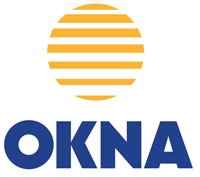NFRC
- Home
- NFRC
OKNA Windows spacers insulate the edge of the glass better than solid foam or metal spacers. Better insulating spacers improve the temperature of the glass, and warmer glass makes you feel more comfortable while using less energy and producing less carbon dioxide pollution. Also, our spacers improve the total U-Value for your windows, which reduces heat loss and save money on energy bills. HeatSeal spacers can save the environment from 1,200 to 16,00 lbs. of CO2 per year for a typical home.
Look For The NFRC Label
The NFRC is a nonprofit organization whose goal is to provide uniform, accurate information about the energy performance of windows, doors, and skylights. In addition to publishing consensus standards (for consistent ratings), the NFRC administers a third-party certification and labeling program to provide the window buyer with verified product information. So, look for an NFRC label on windows to compare products on a fair and equal basis.
Compare Product Performance
The NFRC label provides information on how a window performs. The two most important energy ratings are U-factor and Solar Heat Gain. By reviewing the label information, consumers can make an informed choice about the product that is best for their individual situation.
What Is U-Factor?
U-factor is also known as thermal transmission. It is a measure of the rate of heat loss through a product, therefore, the lower the U-factor, the lower the amount of heat loss. In cold climates, where heating bills are a major concern, choosing windows with lower U-factors will reduce the amount of heat which escapes through a window from inside your house to the outside.
What Is Solar Heat Gain?
The Solar Heat Gain Coefficient, also known as SHGC, measures the rate of heat gain through a product, therefore, the lower the SHGC, the lower the amount of solar heat gain. In hot climates, where air-conditioning bills are a major concern, choosing windows with lower SHGC will reduce the amount of heat that comes in through your windows from the outside.
Look For The Energy Star Label
The U.S. Department of Energy and the U.S. Environmental Protection Agency have developed an Energy Star designation for products meeting certain energy performance criteria. Since the energy efficiency performance of windows, doors, and skylights can vary by climate, product recommendations are given for four climate zones: a mostly heating zone (Northern), two heating and cooling zones (North/Central and South/Central), and a mostly cooling zone (Southern). For more information about ENERGY STAR windows, see www.energystar.gov.
A) U-Factor measures how well a product prevents heat from escaping a home or building. U-Factor ratings generally fall between 0.20 and 1.20. The lower the U-Factor, the better a product is at keeping heat in. U-Factor is particularly important during the winter heating season. This label displays U-Factor in U.S. units. Labels on products sold in markets outside the United States may display U-Factor in metric units.
B) Solar Heat Gain Coefficient (SHGC) measures how well a product blocks heat from the sun. SHGC is expressed as a number between 0 and 1. The lower the SHGC, the better a product is at blocking unwanted heat gain. Blocking solar heat gain is particularly important during the summer cooling season.
C) Visible Transmittance (VT) measures how much light comes through a product. VT is expressed as a number between 0 and 1. The higher the VT, the higher the potential for daylighting.
D) Air Leakage measures the volume of air flowing out of your window due to temperature or air pressure difference between outside and inside your home. Our labels only indicate that the Air Leakage Number is below industry minimum standards. Please ask your certified dealer for the air leakage rating for your desired glass package.
